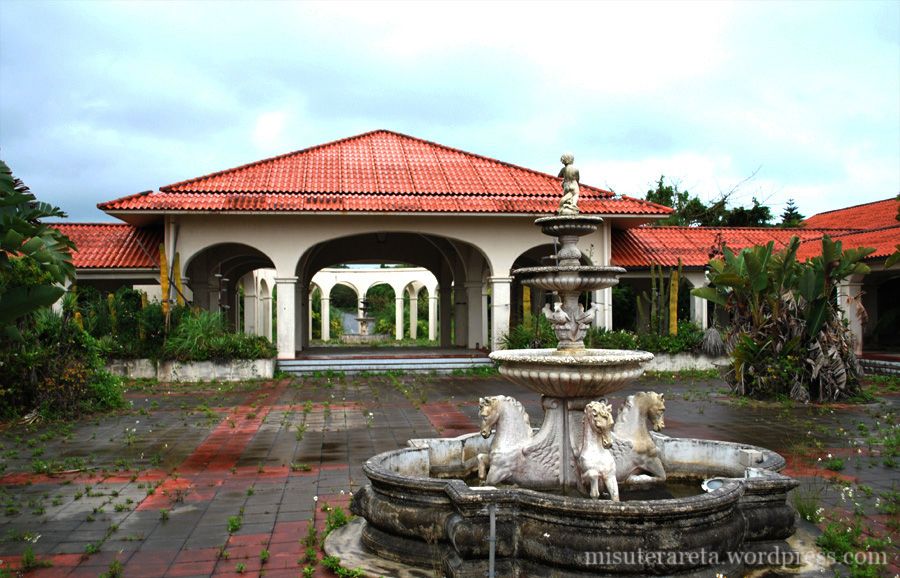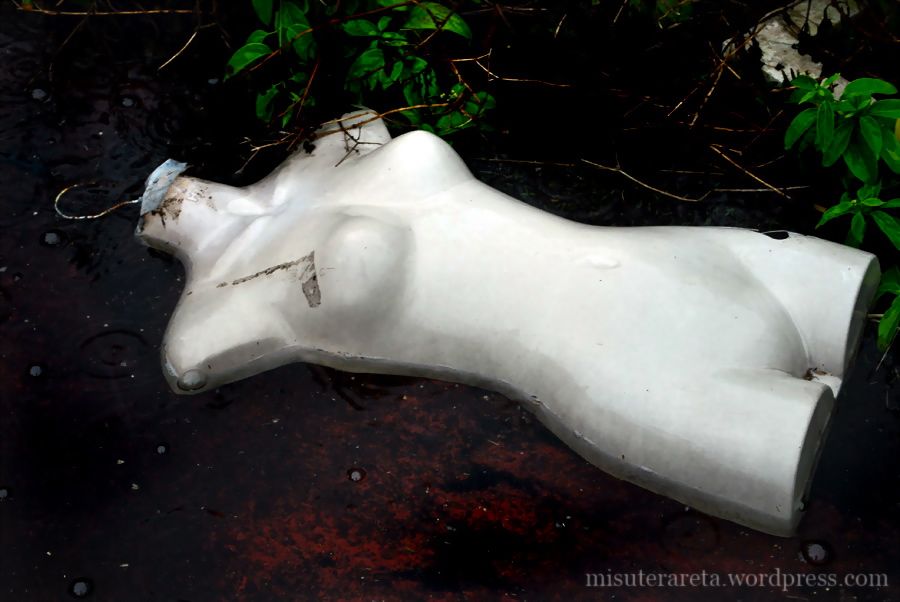The impetus for starting a series of Guest Haikyo posts came from a fellow haikyoist’s web-hosting disaster. Paul’s site Misuterareta (abandoned) was recently lost in toto when his blogging platform ‘Vox’ went under. It seemed a real shame, and I suggested putting excerpts of some of his content up on my site. Happily he ran with the idea, while at the same time starting the long process of getting his old posts back up in full on his new Misuterareta site.
I haikyo-ed with Paul once, where we hit up Namegawa Island and the Yui Love Hotel, and he exhibited an uncanny ability to walk down sodden muddy hill-sides completely upright without slipping once, while I scrabbled on all fours in the muck. Stunning.
We’ll start with Paul’s first Okinawan explore (of 3), an abandoned cactus theme park. You can find Paul’s full post here– I’ve excerpted about half of it below. With that, I’ll let Paul take over.
Giant head at entrance.
From a ruins perspective Okinawa is not a goldmine of locations. The excess and extravagance of the construction from the bubble era looks like it never extended to Japan’s southern most prefecture. Small shops and houses aside I’d say there are around ten unique ruins to find scattered around the island, and no more. I found four, including the largest ruin I think I’ll ever explore (more on that in the next post). Due to its heavy rainfall, strong winds and natural disasters the state of the buildings in Okinawa is generally dirty, run-down, and faded. In short, large areas of the island looked like they were in a state of a ruin. Driving around the island, trying to spot ruins from a distance … was impossible. My usual alertness for finding ruins was completely useless here, I had to rely on the locations I’d found from my research.
I’m still not sure of the exact connection between Okinawa and cacti is, apart from the fact that the climate there is suitable for cacti growth and sustainability. Cacti theme park ruins are as random as they come, here’s what I found.
Day One My wife and I had three days in Okinawa in total. One day of miserable rain, one of beautiful weather and one with a absolute deluge of rainfall. This was the miserable rainy day. I had ample time that day to explore the first Cactus park, the only problem was … there wasn’t much to see. Like the Namegawa Island location I explored with MJG there was a large open space, with a myriad of paths. Which all led to nowhere.
Central courtyard.
There were various mysterious statues scattered around the theme park, some too well covered by undergrowth, some I could get up close to. It was though with some disappointment that I had such a large location to explore, but almost nothing to see. The park was of course filled with slowly decaying cacti and some small buildings which had been neatly cleared out for the most part.
There was an office, kitchen, and dining rooms here – all accessible but not worth documenting. I did find access to a tower of sorts, which gave me a great aerial view of the surroundings. I had the location for another cactus theme park from my research, but other than knowing it was closed I had no idea if there were any remains of it. It could’ve been a parking lot by now for all I knew.
Day Three So having had plenty of time to explore the first (quite ordinary) cactus park the elements were conspiring against us on our final day. Having fitted in some natural heritage sites and ancient ruins in light rain the heavens truly opened in the afternoon. With only an hour and a half left before we had to drop back our rental car I decided to take the gamble on the second theme park. Nothing ventured, nothing gained.
Giant cactuses at entrance.
The sign had fallen off but there she was, still standing. I wasn’t looking forward to stepping out of the car into the torrential rain that afternoon … and indeed this proved to be the most punishing of all the ruins I’d visited. Even with a full rain coat on I’d wrecked the set of clothes I was wearing very quickly. The actual park had a long, entrance road to get down which was already partially flooded.
Rainy entrance.
When I finally made it to the second entrance I could see it … a proper ruin, with all sorts of areas to explore. A random group of crazies had used an abandonded vehicle to repeatedly crash into the front of a building, very cinematic. I was very glad of the shelter that the first large building gave me. Inside was extremely dark but filled with goodies. The smashed remains of a gift shop, snack bar, information centre. Somebody had gone to town with a baseball bat on this place more than once … but sometimes that just adds to the atmosphere of a ruin.
Headless body.
I hope you can see how terrible the weather was from these photos. It was a miracle I could shoot anything in those conditions, I couldn’t chose my angles or take my time … just 40 minutes to cover this place and that was it. There was a cyclical trail similar to the first park to traverse this time as well. The difference was, this park was on a slope, with water rising up and flooding each path rather quickly.
I made it to a hut in the centre called Kachinas Parlor, inside was again smashed to pieces with occasional leftover remnants. Going deeper into the park was just getting myself deeper in trouble. Paths were becoming more overgrown and I couldn’t bear having to wade through the water, weeds and protect myself from the rain. There was plenty more to see, but I was almost out of time.
On my way out.
It was extremely frustrating to find an undocumented, unexplored ruin and not have the time to see even half of it. I exited through the ticket booth area and found even more rooms adjacent to the car park. No time to stop, and no time to regret not coming here sooner … we had to catch our flight.
Park Buggy.
Credit for discovering the first location goes to travel blogger: Yuki Mitsu. Credit for the second ruin: me (Paul Heaton).
To find out more about Paul’s haikyo adventures go to his Misuterareta site, or see all the photos from this explore in his article here. Thanks Paul!
See more Japanese ruins (haikyo) in the galleries:
[album id=4 template=compact]You can also see a curation of world ruins in the ruins gallery.










Comments 1
Thanks for this post, I had been wondering what had happened to the Misuterareta site. Glad to see it is still up and running in a new location.